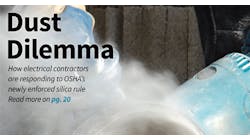It seemed like any other Sunday morning to one job foreman. On his way to church with his family, he happened to pass by one of his construction sites and noticed someone loading a machine onto a flatbed trailer. Although this sight struck him as odd, the foreman wasn't sure if he should stop or not, considering the fact that he had his kids with him. Nevertheless, his curiosity got the best of him, prompting him to pull over and approach the two strangers. Upon confronting the pair, the foreman was reassured — it appeared they were just employees from the leasing company. “We're just bringing in the machine for routine maintenance tonight,” said one fellow. “Don't worry, we'll have it back first thing tomorrow morning for business,” said the other.
Still somewhat puzzled, the man maintained he hadn't called for such service. Sensing his skepticism, one of the men immediately handed him some paperwork printed on the leasing company's letterhead, confirming all of the particulars of the said request. After looking at this official documentation, the foreman realized he must have been mistaken and let the men proceed with their work. Much to the foreman's dismay, the next morning the machine was nowhere to be found. Immediately calling the leasing company to get to the bottom of this mix-up, the man still had no clue he had been “had.”
Explaining that the leasing company's people had picked up the machine for routine maintenance the night before, the foreman was shocked to hear that the leasing company had no record of this transaction. “But I spoke to your people; I saw the paperwork,” demanded the foreman. “Where's my machine?” Apparently, stolen.
The narrative described above is just one of many true stories Glen Sider can quickly relay off the top of his head when talking about heavy equipment theft in the United States. He is the operations manager at New York-based National Equipment Register, an organization formed in 2001 that has developed databases, which currently house more than 13 million records, to track heavy equipment ownership, theft information, and related services to increase the recovery rate of stolen equipment and reduce the costs associated with theft for owners and insurers. This is one of many examples that shows just how savvy equipment thieves can be.
In an effort to track national theft trends, NER's third annual “Equipment Theft Report” takes a deeper look into statistics drawn from the company's database of more than 77,000 thefts of construction and farm equipment, including data from the Insurance Services Office (ISO), the five largest rental fleets in North America, and hundreds of smaller ones through a partnership with the American Rental Association, Moline, Ill. According to the report, estimates of the total value of equipment stolen annually in this country range between $300 million and $1 billion — not including losses from business interruption such as short-term rental costs, project delay penalties, and wasted work time (see “The Cost of Equipment Theft,” on page C32).
“The important thing to note when looking at this data is to realize that not all thefts are reported,” Sider says. “With heavy equipment not being titled, registered, or listed on the DMV or national government-run database, NER's theft system is really the only thing we can look at on a national level as to what's happening out there. This data comes from loss reports submitted from insurance companies, equipment owners, rental fleets, and law enforcement. This information is a good portion of the thefts out there, but it's definitely not all of them.”
Keeping in mind that less than 10% of stolen equipment is ever recovered, it's important for contractors to stay on top of theft trends in an effort to increase loss prevention. Breaking down the statistics by category, it's easier for end-users to see a snapshot of the most significant national equipment theft trends.
Theft by state. Although thefts were reported to NER from every state, the top five states accounted for 39% of the total number of thefts in 2005, while the top 10 made up 57% (Fig. 1 below).
According to NER, the overriding factor related to the “regionality” trend is the amount of targets in each state. Theft rates closely follow equipment volume — so it stands to reason where there is more equipment, there is usually more theft.
Obviously, states with the highest volume of construction and agriculture have the highest number of thefts. The other important consideration is the number and level of activity of equipment thieves in any area. Areas with a high concentration of equipment and more potential buyers of stolen used equipment are more likely to encourage the development of more organized theft rings. This is reflected in higher loss ratios for insurers in certain areas. Sometimes theft “hot spots” emerge when an organized group of thieves working in a particular area. When these groups are detected and closed down, a noticeable drop in theft rates is sometimes seen.
“Generally, equipment theft frequency follows the amount of construction happening in a given area because it's all a matter of inventory,” Sider explains. “That's why Texas, California, and Florida will always be in the top five.”
Theft by location. As shown in Fig. 2 right, heavy equipment spends most of its time on others' premises, typically characterized by much lower levels of physical security than their insured counterparts, who commonly have fences. As shown in the graphic, a very low number of machines were stolen in transit.
According to NER, it is not enough to focus solely on the security of premises and worksites because in many instances a worksite cannot be adequately secured (see “Thwarting Heavy Equipment Thieves” on page C34). Thieves have good knowledge of equipment operation and security weaknesses. According to NER, in some cases these are criminals who learn about equipment or who pay those in the business for help and information. In other cases, they are already familiar with equipment and see an opportunity to make more money in stealing equipment to “supplement” their existing income. Having stolen and sold one machine and found how easy it is, they continue. In fact, most arrests lead to multiple recoveries.
“Generally, equipment is stolen while unattended,” Sider explains. “So whether it's sitting out in the field, on the farm, on an unattended jobsite in the middle of Denver, or by the side of the road, that's where the thefts are happening. It's usually either someone in the organization who knows the equipment is vulnerable and wants to make extra money, someone who has a bone to pick so they tell someone that they know wants to steal machines how to get them, or it's a complete outsider who just has an order for two backhoes and two skid steers that just cruises around town all day looking for the right machines.”
Theft by equipment type. Similar to the top five states for the highest levels of equipment theft, the top five most common types of equipment stolen account for an even more startling statistic: a whopping 78% of all losses nationwide (Fig. 3 below).
Based on NER analysis of this data, the two key factors in the type of equipment most likely to be stolen are value and mobility — the higher the value of an item and the easier it is to transport, the greater the chance of theft. Another factor to consider is the amount of each type of equipment in circulation. For example, it is estimated that skid steer loaders accounted for more than 30% of new construction equipment sold in the United States in the last five years. While dozers and wheel loaders are the most valuable equipment in NER's “top 10,” tractors, backhoes, and skid steers are the most easily transported. When theft is measured by value rather than frequency, dozers move above generators.
Many times, value will also trump mobility. About a month ago, Sider got a rather curious call from a police officer at a job site that reported the anonymous addition of a machine rather than the typical lack thereof reported in an equipment theft scenario. However, the motive in this case ultimately demonstrated the value/mobility proposition to a tee. “The guys arrived on the job site Monday morning and found this dozer just sitting there,” Sider says. “Upon closer, inspection, they found that one of their backhoes was stolen. So the thief obviously stole the dozer, kept driving, got to this jobsite, saw the backhoe that he preferred, dumped the dozer, stole the backhoe, and went on his way. This was a case of I'll steal your diamonds, but I'll bring you some gold.”
Why are skid steers the most stolen piece of heavy equipment? “Normally, all you need to do to get a skid steer is to get it onto a flatbed and then you can drive it away,” Sider says. “Even if you hook up a winch and yank it up there, you might cause some damage but you're going to get it.”
Another vulnerability is what Sider characterizes as the “one-key-fits-all problem” with heavy equipment. “Certain manufacturers will make one key that starts everything, or will start every backhoe in their line let's say,” Sider says. “We went on eBay a few years ago just to prove that it could be done, and for about $50 you could buy a single key ring with a little silhouette map of each key that had about 20 or 30 keys on it. With those keys, you could almost drive around town and start any piece of equipment.”
Unfortunately, this problem doesn't have a quick fix, Sider explains. “We've got to be careful who we condemn when we bring this point up, because contractors value productivity,” Sider says. “If they had to maintain individual keys for every single machine, what would happen the day Bill calls in sick? Is the backhoe completely unproductive that day? We can't point too many fingers, but what we can do is acknowledge that it creates a serious vulnerability.”
Age of stolen equipment. Equipment produced since 2000 accounted for 78% of thefts reported to NER in 2005, according to the report. The top 10 were also the most recent 10 years of manufacture (Table 1). Stemming from the value/mobility theory discussed earlier, it's natural to assume that the newer the piece of equipment, the more likely it is to be stolen.
If given the choice between two similar machines that are as easy to steal, a thief will chose the most valuable machine. According to NER, this is in contrast to the trend in auto theft where older models account for more stolen cars. This is because newer cars carry more sophisticated anti-theft technology whereas heavy equipment design is still driven primarily by productivity such as the need for multiple users to be able to operate a single machine.
Theft by make. Caterpillar topped the list of most common makes of equipment reported stolen to NER in 2005. Other well-known brands followed (Table 2).
Because all makes of off-road equipment have similar levels of equipment security, NER analysis of this statistic suggests that this list is primarily an indication of which manufacturers make the most compact equipment and does not necessarily follow market share for all types of equipment. If two machines are equally easy to steal, for example, a thief is likely to steal the more valuable unit. Value depends primarily on age and condition, but may also take brand into consideration.
“I think heavy equipment is like any other kind of theft in a sense that you want to steal something you know you can move,” Sider quips. “I say ‘move’ as in ‘sell’. If you want to sell a stolen item, you want it to be from a manufacturer people have heard of, and you want it be an attractive machine — some of these things get pretty battered so the newer it is, the better it looks.”
When asked if thieves typically make an effort to disguise stolen equipment, Sider reveals an interesting observation. “I think some of the savvier thieves might do this, but you've got to remember there's not much of a need to disguise a machine when you can go to Bob's Used Equipment in the next county and sell it for cash that day,” he says. “If someone's disguising the machine, it's typically not from law enforcement. It's to disguise it from other contractors who might be out looking for their lost machine.”
Recovery rates. An analysis of thefts reported to ISO by insurers since 1990 showed 6.5% marked as recovered. Not surprisingly, the models and brands of equipment most often recovered closely mirror the types of equipment most commonly stolen. “I think 10% to 15% recovery rate is the highest range we've seen,” clarifies Sider, who maintains this reality results from a combination of things. “One thing is the police typically aren't experts in identifying these machines, which is understandable,” he says. “They also have priorities that are obviously more pressing, which is also understandable. Then you have all these data errors that occur.”
To illustrate this point, Sider says it's very common for equipment owners to not even know a piece of equipment has been stolen or report the wrong one once they do become aware of the crime. He believes the low recovery rate is due to several factors, including the delay in theft discovery and reporting, inaccurate or non-existent owner records, the lack of pre-purchase checks in the used equipment market, limited resources that law enforcement can dedicate to equipment investigations, the difficulty of equipment investigations due to the complexities in equipment numbering systems, and the limited amount of accurate equipment information available to law enforcement.
In 2005, most machines were recovered in the same state in which they were stolen. Of those recovered in another state, few moved beyond the neighboring state. The bigger the state and the more demand for equipment within that state, the lower the chance equipment will leave that state. The longer the time from the theft, the more likely the equipment was to have moved out of state and be in the possession of a purchaser who seemed to have no knowledge of the theft.
Ironically, the first recovery NER ever made in 2001 was for a machine that had been missing from the job site for six months before the owner realized it was stolen, says Sider. “That was our initiation into what was happening out there,” says Sider, citing the lack of due diligence in the used equipment marketplace as a major culprit in the equipment theft problem — not to mention Internet auctions. “If you bring a backhoe into a used equipment dealer and say ‘I'd like to put this in your auction,’ there's a limited due diligence system in the used equipment market. So what you have is thieves pretty much steal these items and then resell them back into the used equipment market without much fear of ever getting caught because they're not titled or registered.”
He explains that heavy equipment typically does not have standardized serial numbers similar to the 17-character VIN number on automobiles; however, he notes that although it has not been widely adopted yet a similar format was ratified in 2001 for earthmoving machines. This format is not exactly the same as auto VINs, Sider says, so quality control is still difficult for law enforcement. “What you have is hundreds of equipment manufacturers with countless variations of serial number formats,” he says. “Within a model line, they could change or repeat serial numbers on different models.”
It's conceivable then, maintains Sider, that if a police officer has pulled someone over on the side of the road, he or she may not find any matching theft information when they check a machine — even if it does exist — because of input data errors. “For example, you could submit a police report that your backhoe was stolen and provide the serial number. Then two years down the road, when a different police officer in a different part of the country sees the stolen machine, if he doesn't query the police system in exactly the same way that it was entered two years earlier by the original officer, the inquiry and the original report are not going to mesh. So he's going to let the thief go on down the road.”
Despite the challenges that continue to plague the construction industry, there are steps contractors can take to protect capital investments. Their first line of defense should be making more accurate information available on heavy equipment to law enforcement. Preventive steps, such as those discussed in this article, as well as registering equipment with NER for a nominal fee, can lead to large payoffs in risk management.
Editor Note: This article includes material excerpted with permission from NER's “2005 Equipment Theft Report.”
Sidebar: Cost of Equipment Theft
The top five reasons high levels of equipment theft seem to plague the construction and agricultural industries include:
-
High value of heavy equipment.
-
Ease with which equipment can be stolen due to poor equipment management and site security.
-
Ease with which stolen equipment can be sold in the used equipment market.
-
Low risk of detection and arrest for thieves.
-
Minor penalties if prosecuted and convicted.
Sidebar: Thwarting Heavy Equipment Thieves
Securing your premises is not enough when it comes to protecting heavy equipment from potential thieves. Equipment should be made more secure, even if it is a temporary measure, which might mean restricting the movement of more mobile items with the strategic positioning of larger equipment when not in use. Following are some tips taken from NER's “Loss Prevention and Security Techniques for Equipment Owners” report to help contractors improve risk management procedures on the job site — many of which are cost-free.
Management considerations
-
Make your theft prevention policy part of your business plan, and link it to incentives for employees.
-
Conduct unannounced and random worksite visits to ensure nothing unusual is occurring while work is not in progress.
-
Consider hiring a guard service to monitor your worksite and/or installing video surveillance systems.
-
Work with local law enforcement before a theft occurs. Request that police make drive-by checks of your site after-hours and on weekends.
-
Keep a detailed and accurate inventory of all equipment on a given worksite, including a record of equipment location assignments, the dates of delivery, and anticipated return.
Site security
-
Post warning signs indicating that equipment on your site all have their product identification numbers recorded in a central location within your company and possibly on a national database.
-
Fencing is your first and best line of protection in many ways. However, its effectiveness depends on the design and quality of the installation.
-
Use barriers when fences are not feasible, or in addition to fencing to enhance security. Barriers can include low walls, posts, dirt berms or ditches, which prevent a unit from being driven or towed from the worksite.
-
Lighting is one of the most valuable deterrents, as most thefts occur at night. Place lights near the perimeter of the property and direct them toward the worksite.
Vehicle security
-
Anchor equipment that must be left on the jobsite with chain or cable and paint it with a bright color.
-
Consider installing theft prevention devices on higher risk or higher value equipment to disable fuel, hydraulic, and/or electrical systems.
-
Ensure that all equipment is returned to its proper place, or an otherwise secure area, upon completion of a task or at the end of the day.
-
Arrange/store equipment not in use in such a manner that a missing unit would be obvious, such as a single file row.
-
Position larger pieces of equipment in a circular, wagon-train pattern, with generators, compressors, and other small items inside the ring.
-
Avoid leaving equipment on a trailer unattended. If this is unavoidable, consider unloading the unit and securing it to the trailer's hitch.




